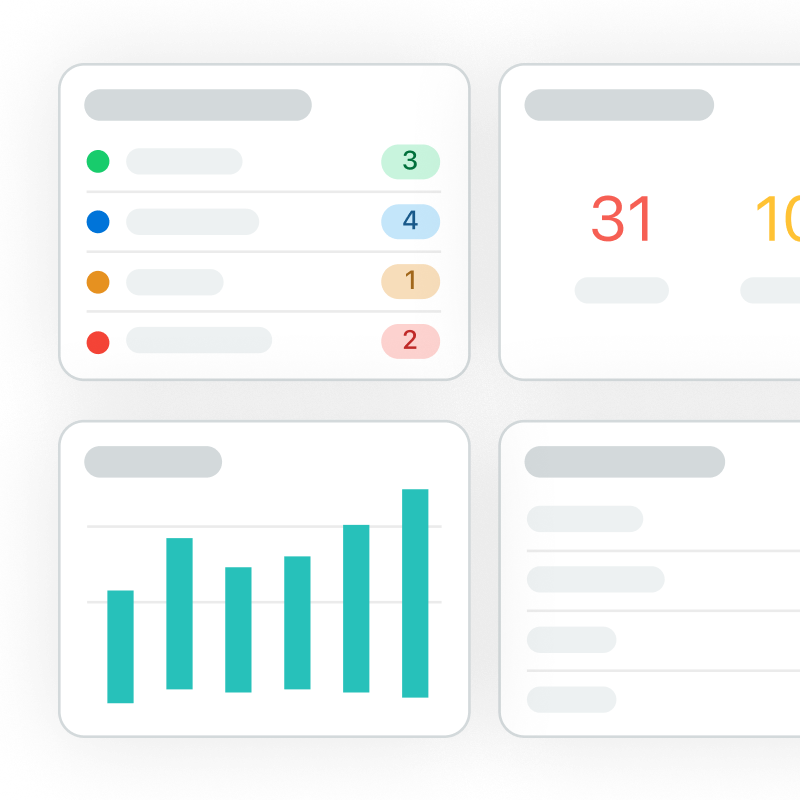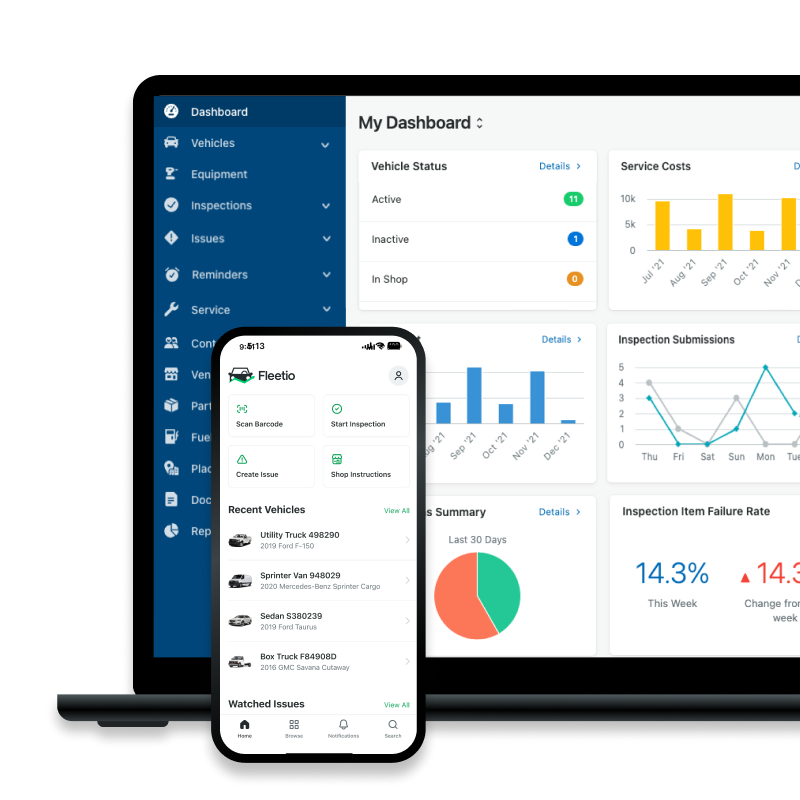10 Optimization Metrics Every Fleet Should Be Tracking
Fleet optimization is about more than just the maintenance processes that keeps your vehicles on the road – it’s about running your operations as efficiently as possible while minimizing costs, extending the life of your assets and maintaining safety and compliance. But what does “optimization” really mean for fleets?
Sep 27, 2024
9 min read

What is fleet optimization?
At its core, fleet optimization focuses on four key areas:
- Reducing Costs: Saving every cent possible without detracting from optimal operation and asset count
- Maxing Efficiency: Making sure vehicles are being utilized effectively and routes are planned intelligently while extending vehicle lifespan in the process
- Improving Safety and Compliance: Ensuring efficiency through consistent incident analysis and proactive measures
- Prioritizing sustainability: Finding ways to push closer to environmental and emissions goals year-over-year
Achieving true fleet optimization starts with tracking the right fleet management metrics. Here are the top 10 metrics every fleet manager should be paying attention to if they want to tap into their fleet’s full potential.
Jump to a Section
Sustainability and Environmental Impact Metrics
Cost-Related Metrics
1. Total Cost of Ownership
Total cost of ownership is the cornerstone of fleet management optimization – it represents the true, actual long-term cost of owning and operating a vehicle, including purchase price, depreciation, maintenance, fuel and even downtime costs. By calculating and tracking TCO for each asset, fleet managers can make informed decisions about vehicle purchases, replacements and utilization.
Understanding TCO can help identify the hidden expenses that eat into your bottom line, allowing you to optimize vehicle selection as you add more assets to your fleet, as well as retirement strategies, so you can get the maximum bang for your buck when disposing of aging assets.
How to track TCO: We’ve got a whole guide that can break this down for you – and it’s completely free.
FOR FLEETIO USERS
The Total Costs Trends report, listed under Vehicles in your Reports dashboard, aggregates all of your vehicle data to analyze costs over time.
2. Fuel Efficiency
Fuel costs can account for a significant portion of a fleet’s operating expenses – in our Fleet Benchmarking Report, Fleetio users reported that fuel comprised half of their total budgets. It should come as no surprise then that fuel efficiency should be a key metric for optimization.
Tracking fuel consumption per vehicle not only helps you monitor costs but also highlights opportunities to improve fleet efficiency. But understanding fuel efficiency is more than logging gas station receipts – it’s an integrated strategy of optimizing routes, maintaining consistent tire management and providing regular preventive maintenance. Moreover, monitoring driver behavior like harsh braking or excessive idling can reveal opportunities to further reduce fuel usage.
How to track Fuel Efficiency: In addition to tracking regular maintenance in a fleet optimization software, onboarding a telematics solution to track routes, driver behavior and DTCs can help you ensure optimal routing and notify you of any engine issues that could impact fuel consumption. You’ll also want to utilize fuel cards, so you can track fuel spend per asset and notice any outlying expenses that could indicate decreasing fuel efficiency. Check out our integration partner library to explore telematics and fuel card providers.
FOR FLEETIO USERS
Run a Fuel Summary report, found in your Reports dashboard under Fuel, to see summarized metrics per vehicle.
3. Maintenance Cost per Mile
Tracking maintenance and cost per mile (CPM) individually is a great precursor to tracking maintenance cost per mile. While it’s not much different than tracking CPM specifically, it’s important to understand maintenance costs relative to the distance your vehicles travel if you want direct insight into how efficiently your fleet is running without the noise of other invariable costs.
This metric can help fleet managers spot potential issues, such as rising costs for older vehicles or vehicles that require frequent repairs. By implementing predictive maintenance programs and using fleet management analytics to track vehicle health, fleet managers can avoid costly breakdowns and reduce maintenance costs over time.
How to track Maintenance Cost per Mile: Keep a running log of maintenance costs, and simply divide that costs by the asset’s total mileage. Continue tracking Maintenance CPM month over month to identify trends.
FOR FLEETIO USERS
Under the Service tab in your Report dashboard, the Service History by Vehicle report can quickly summarize all service costs associated with your assets, and you can also use the Cost/Meter Trend report in the Vehicles tab to see vehicle costs per meter of your choice over time.
Asset Efficiency Metrics
4. Vehicle Utilization Rate
Vehicle utilization rate measures the percentage of time a vehicle is in use compared to its availability. A low utilization rate across multiple assets could mean you're running a larger fleet than necessary, which increases costs without improving operations, and a high utilization rate could predict more frequent PM spend and shortened lifespan on an individual asset. By tracking this metric, fleet managers can better understand which vehicles are being under or over utilized and adjust fleet size or distribution accordingly. Optimizing utilization ensures that you’re getting the most out of each asset and maximizing fleet efficiency.
How to track Vehicle Utilization Rate: You can track utilization by measuring either vehicle mileage or time in use – whichever is more useful to you.
FOR FLEETIO USERS
Run a Utilization Summary report, found in your Reports dashboard under Vehicles, to see usage per vehicle based on meter entries.
5. Idle Time
Idling is often an overlooked expense, but it can lead to wasted fuel and unnecessary wear on vehicles. By tracking idle time, fleet managers can identify inefficient driver habits and opportunities to cut down on fuel consumption. Implementing driver training programs, setting idle time limits, or using telematics solutions to monitor and reduce idle time are great ways to address this issue head-on, showcasing a key part of fleet manager skills.
How to track Idle Time: Telematics and GPS solutions are key to tracking engine idling. Find a way to pull idling data from your telematics devices and continue to track it over time to spot any trends.
FOR FLEETIO USERS
Fleetio integrates directly with multiple telematics and GPS providers, which means you can pull their insights straight into your Fleetio dashboard.
Want an optimized fleet? Start reporting.
Optimizing your fleet means reporting on the metrics that matter most. Fleetio can take your fleet data and turn it into customizable, shareable insights in a few clicks.
Explore our reports6. Route Optimization Effectiveness
An optimized route is one of the easiest ways to improve fleet efficiency. Route optimization metrics track how effective your routing plans are in terms of fuel savings, on-time deliveries, and overall productivity. Tools that offer real-time traffic data and intelligent route planning can help ensure that your vehicles spend less time on the road and more time delivering value.
How to track Route Optimization: Again, telematics and GPS capabilities are your best friend here. Find the right partner to make sure your routing is optimized for efficiency.
Safety and Compliance Metrics
7. Accident Frequency Rate
Safety should always be the number one priority in any company, but especially in fleet management, and tracking accident frequency is key to improving fleet safety across the board. Monitoring how often accidents occur allows fleet managers to identify patterns or risk factors that need addressing – whether it's driver behavior, vehicle condition, or route challenges. Reducing accidents not only protects your drivers but can also lead to lower insurance premiums and an enhanced company image while protecting the public at large.
How to track Accident Frequency Rate: There are two different ways to calculate accident frequency rate – by time or by mileage. For time, find the average number of days between accidents and divide that by days in a month, quarter or year to get an actual percentage rate. For mileage, you can multiply the number of vehicle accidents by 1,000,000 miles and divide by the mileage driven for a given period of time.
8. Vehicle Inspection Compliance Rate
Regular vehicle inspections are essential for preventing costly breakdowns and ensuring compliance with safety regulations. By tracking the compliance rate of vehicle inspections, fleet managers can stay ahead of potential issues before they escalate. Encouraging a culture of thorough, consistent inspections will ensure that fleet vehicles remain in peak operating condition, reducing downtime and the risk of non-compliance penalties. Leveraging fleet management analytics to keep track of inspection data can further streamline this process.
How to track Vehicle Inspection Compliance Rate: Collect daily vehicle inspection reports, whether it’s a physical form or digital entry, and keep a running percentage of inspections completed that can be attributed to either individual assets or drivers.
FOR FLEETIO USERS
You can find more details about your fleet's inspection compliance rate in Inspection History in the left sidebar navigation under Inspections. You can also view due dates and Last Inspection time stamps for your vehicle inspection schedules under Inspection Schedules in Reports.
Sustainability and Environmental Impact Metrics
9. Emissions Levels
With growing pressure to reduce carbon footprints, tracking emissions has become more important than ever for fleets aiming to be environmentally responsible. Monitoring your fleet’s emissions levels allows you to identify areas where you can cut back, whether it’s through adopting cleaner fuels, upgrading to more fuel-efficient vehicles, or reducing idle time.
Fleet managers should take care to stay updated on emissions regulations to ensure compliance and take advantage of any available incentives for reducing emissions.
How to track Emissions Levels: A combo of fuel cards, telematics and fleet management software is the best way to consistently monitor emissions.
10. Green Fleet Percentage
The percentage of eco-friendly vehicles in your fleet is a clear indicator of your commitment to sustainability. For fleets with a larger pool of assets, tracking this metric over time gives you a snapshot of how your fleet is evolving in terms of environmental impact. Whether it’s transitioning to electric vehicles or integrating hybrids, increasing the percentage of green vehicles will not only benefit the planet but also reduce operational costs over the long run.
How to track Green Fleet Percentage: Track the total number of EVs or hybrid assets you own and divide it by your total asset count.
Optimization starts with Fleetio
The key to optimizing your fleet is having the right software partner to get you there. Fleetio is an optimization platform designed to take your data and turn it into usable insights that can take your fleet above and beyond.
Get to know Fleetio
Senior Fleet Content Specialist
As a Senior Fleet Content Specialist at Fleetio, Peyton explores the voices and experiences that shape fleet operations. She focuses on how fleet professionals adopt technology, improve efficiency and lead their teams to bring clarity and context to the challenges happening across the industry.
View articles by Peyton PanikReady to get started?
Join thousands of satisfied customers using Fleetio
Questions? Call us at 1-800-975-5304

